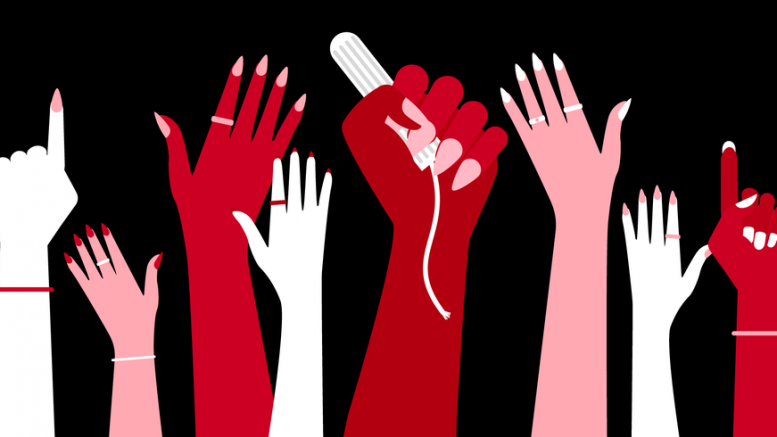On average, 50% of us will have a period, and yet menstruation is rarely talked about.
Menstrual stigma is rooted deeply into society. Commercials for pads often use a representative blue liquid to demonstrate the absorbency of their product instead of a red liquid that would more accurately depict menstrual blood. It is a cultural norm to use terms like “that time of the month,” “aunt flow,” or “shark week” to describe one’s period. Countless euphemisms have been made up as a less awkward, even humorous way to talk about menstruating. Additionally, it is common practice amongst those who menstruate to go to great lengths to conceal their menstrual hygiene products. Conversations about the most effective ways to hide a pad or tampon, whether it’s under a waistband, in a purse, or elsewhere, are commonplace. Concealing period products is so important to menstruators that many companies have advertised products that are quieter to open or more “discreet.” All of these practices perpetuate menstrual stigma and teach young menstruators that their period is something to be ashamed of and hidden.
Period poverty is a public health crisis. 500 million people experience this issue worldwide, and in several countries, the majority of menstruators cannot afford or access period products. Women are ostracized by their communities during their period because of the lack of knowledge relating to menstruation. Period poverty can also impact menstruating youth’s access to education. The United Nations Educational, Scientific and Cultural Organization (UNESCO) reported in 2014 that 1 in 10 menstruators miss school while on their period due to not having proper menstrual products.
Studies have shown that period poverty can also result in significant mental health consequences. An article published in BMC Women’s Health found a link between a lack of access to period products and depression amongst college-aged menstruators. Menstrual stigma adds to the burden period poverty can place on mental health. When forced to conceal your struggles, they become more intense and you become more isolated.
States have implemented various policies regarding menstrual equity — while some states have taken steps to require free menstrual products in all institutions and eliminate barriers to accessing products, others still have yet to remove discriminating policies, such as the Tampon Tax. In May of 2021, Representative Grace Meng (D-NY) introduced the Menstrual Equity for All Act of 2021, which aimed to address period poverty at the federal level. The bill would give states the ability to use federal grant funds for providing free period products in institutions such as schools and prisons; incentivizing colleges to start pilot programs for free period products, ensuring that Medicaid covers the cost of products, requiring all federal buildings, including the U.S. Capitol to supply free products in bathrooms, and more. Comprehensive menstrual equity legislation, such as this one, is what is needed to fully address the issue of period poverty.
The Menstrual Equity Initiative under IMSA’s Gender Equity Association held Period Awareness Month throughout March. Boxes in which period products could be donated were located in each residence hall and in Old Caf. The menstrual products were given to Hesed House, a homeless shelter in Aurora. To educate students about period stigma and poverty and encourage them to take part in menstrual equity activism, GEA’s weekly events included Period Bracelet Making, a screening of the Oscar-award-winning film, Period. End of Sentence., witness slip signing for menstrual equity-related bills, and a GA with leading organizations, She Votes Illinois and PERIOD.






Be the first to comment on "Menstrual Inequity is a Crisis"